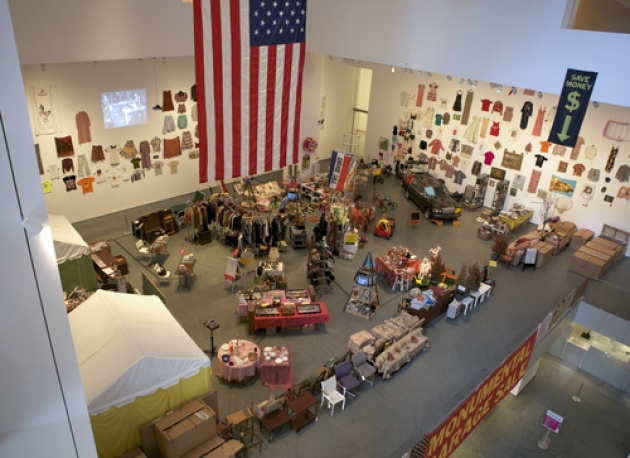What the online fashion community can learn from Flea Markets: Bringing it back to the physical space
On Saturday, November 17th, I made a visit to the ever-trendy Museum of Modern Art (MoMa) for its latest exhibition, the Meta-Monumental Garage Sale. Presented by New York-based artist, Martha Rosler, the exhibition is a ‘large-scale version of the classic American garage sale.’ Here, viewers of the exhibition, who were also shoppers, could browse and buy second-hand goods that were organized, displayed and sold by the artist. Objects resembled those of a typical garage sale, which were donated by the artist, MoMa staff and the general public.
Flea markets and the idea of vintage shopping gained popularity a few years ago with celebrities like Alexa Chung showcasing their vintage finds in the spotlight. The fun in flea market shopping comes from the hunt: digging through the clutter to find the gem(s).
At flea markets, as quoted by Edith Wharton, “an object is always more than what it is… value is ascribed to it, value is withdrawn; value is regenerated.” In order to describe this value, shoppers interact with the sellers in this space, often a backyard, garage, or in this case, the MoMa’s Atrium. In a sense, a community is formed in this space, bringing like-minded people who are interested in the type of goods sold together.
“Community connotates something face-to-face, personal, and empathic, something with rules and boundaries and limits- “values” in contrast to start capitalist “value,” wrote Christine Smallwood, a writer in New York who contributed to the exhibition’s newspaper, the Garage Sale Standard.
Why then, were most of the engagement/community management jobs offered today revolving around social media?
Currently, the marketing buzz revolves around the digital space. Perhaps companies are realizing that an online presence is essential to target the current consumer generation, or perhaps the present slump in the economy has encouraged smaller budgets, which makes digital initiatives a feasible idea; whatever it is, it seems that “digital” is inevitable.
Yet, limitations do occur in the digital space. Communities can only exist so far in the digital realm before customers, consumers and individuals yearn for physical interaction with the product, or with other individuals.
As written in a previous blogpost (http://modelswebtv.com/blog_post/a-place-for-film-in-fashion-media/57389), many e-commerce stores have chosen to replicate the shopper’s experience in the digital space through story telling, in the form of videos, narratives and online conversations. However, this might not be enough. As community members want to feel a sense of belonging with similar values, so do shoppers of this age, who identify themselves with the brands they choose to support and associate with. Furthermore, the ultimate product of fashion is tangible, giving more reasons for e-commerce stores to tap into “offline” opportunities. “People will always want to touch, feel and try on certain items and it is impossible to replicate that online,” said Dave Gilboa, co-founder of Warby Parker who originally intended his company to be exclusively online, but realized the need for a physical space.
It is time fashion e-commerce stores start thinking about integrating their digital efforts with a physical space. As the trite saying goes, Seeing is after all, Believing.
Meta-Monumental Garage Sale (installation view). 2012. Photo by Shannon Darrough




